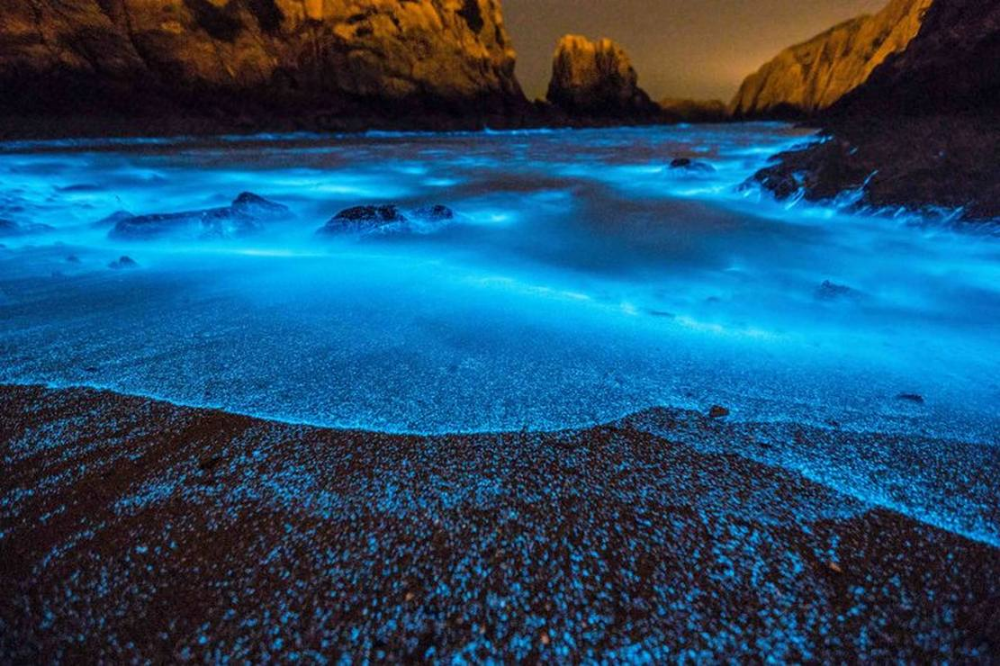Bioluminescent: What is bioluminescence?
Bioluminescence
Bioluminescence is light produced by a chemical reaction within a living organism. Bioluminescence is a type of chemiluminescence, which is simply the term for a chemical reaction where light is produced. (Bioluminescence is chemiluminescence that takes place inside a living organism.)
Bioluminescence is a “cold light.” Cold light means less than 20% of the light generates thermal radiation, or heat.
Most bioluminescent organisms are found in the ocean. These bioluminescent marine species include fish, bacteria, and jellies. Some bioluminescent organisms, including fireflies and fungi, are found on land. There are almost no bioluminescent organisms native to freshwater habitats.
Chemistry
The chemical reaction that results in bioluminescence requires two unique chemicals: luciferin and either luciferase or photoprotein. Luciferin is the compound that actually produces light. In a chemical reaction, luciferin is called the substrate. The bioluminescent color (yellow in fireflies, greenish in lanternfish) is a result of the arrangement of luciferin molecules.
The bioluminescent color (yellow in fireflies, greenish in lanternfish) is a result of the arrangement of luciferin molecules.
Some bioluminescent organisms produce (synthesize) luciferin on their own. Dinoflagellates, for instance, bioluminesce in a bluish-green color. Bioluminescent dinoflagellates are a type of plankton—tiny marine organisms that can sometimes cause the surface of the ocean to sparkle at night.
Some bioluminescent organisms do not synthesize luciferin. Instead, they absorb it through other organisms, either as food or in a symbiotic relationship. Some species of midshipman fish, for instance, obtain luciferin through the “seed shrimp” they consume. Many marine animals, such as squid, house bioluminescent bacteria in their light organs. The bacteria and squid have a symbiotic relationship.
Luciferase is an enzyme. An enzyme is a chemical (called a catalyst) that interacts with a substrate to affect the rate of a chemical reaction. The interaction of the luciferase with oxidized (oxygen-added) luciferin creates a byproduct, called oxyluciferin.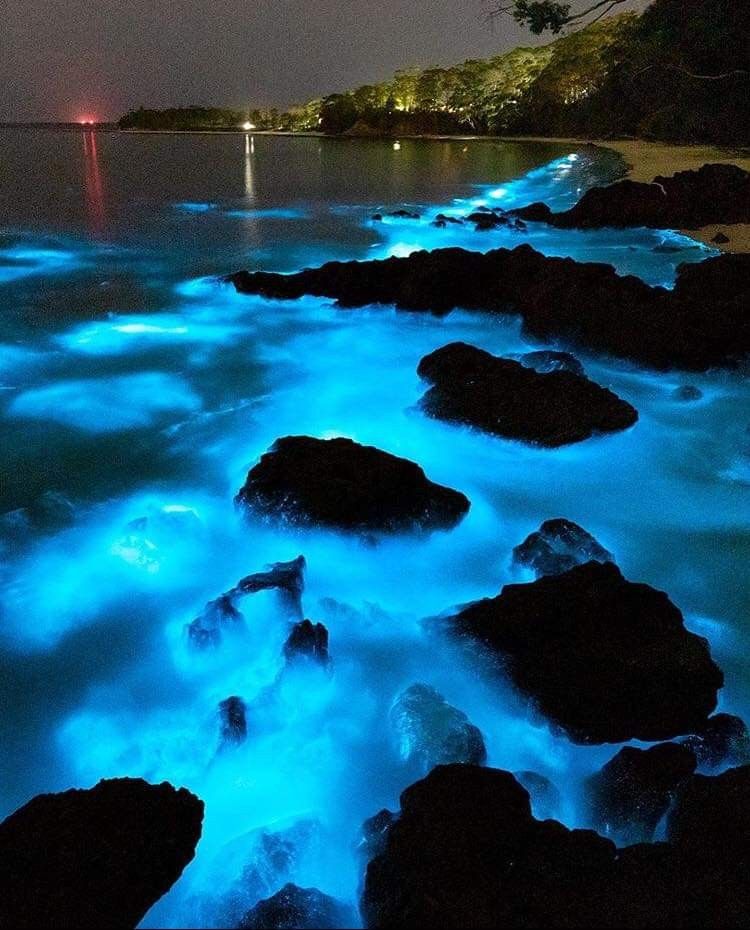 More importantly, the chemical reaction creates light. Bioluminescent dinoflagellates produce light using a luciferin-luciferase reaction. The luciferase found in dinoflagellates is related to the green chemical chlorophyll found in plants.
More importantly, the chemical reaction creates light. Bioluminescent dinoflagellates produce light using a luciferin-luciferase reaction. The luciferase found in dinoflagellates is related to the green chemical chlorophyll found in plants.
Bioluminescent dinoflagellate ecosystems are rare, mostly forming in warm-water lagoons with narrow openings to the open sea. Bioluminescent dinoflagellates gather in these lagoons or bays, and the narrow opening prevents them from escaping. The whole lagoon can be illuminated at night. Biologists identified a new bioluminescent dinoflagellate ecosystem in the Humacao Natural Reserve, Puerto Rico, in 2010.
Most bioluminescent reactions involve luciferin and luciferase. Some reactions, however, do not involve an enzyme (luciferase). These reactions involve a chemical called a photoprotein. Photoproteins combine with luciferins and oxygen, but need another agent, often an ion of the element calcium, to produce light.
Photoproteins were only recently identified, and biologists and chemists are still studying their unusual chemical properties.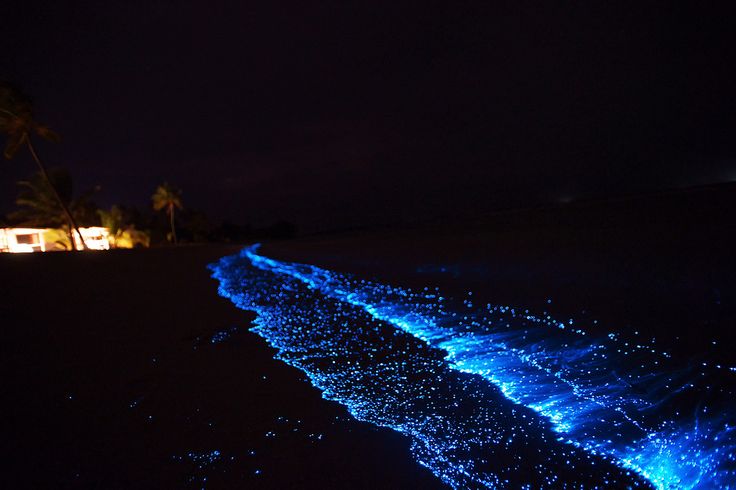 Photoproteins were first studied in bioluminescent crystal jellies found off the west coast of North America. The photoprotein in crystal jellies is called “green fluorescent protein” or GFP.
Photoproteins were first studied in bioluminescent crystal jellies found off the west coast of North America. The photoprotein in crystal jellies is called “green fluorescent protein” or GFP.
Bioluminescence is not the same thing as fluorescence, however. Florescence does not involve a chemical reaction. In fluorescence, a stimulating light is absorbed and re-emitted. The fluorescing light is only visible in the presence of the stimulating light. The ink used in highlighter pens is fluorescent. Phosphorescence is similar to florescence, except the phosphorescent light is able to re-emit light for much longer periods of time. Glow-in-the-dark stickers are phosphorescent.
Bioluminescent Light
The appearance of bioluminescent light varies greatly, depending on the habitat and organism in which it is found.
Most marine bioluminescence, for instance, is expressed in the blue-green part of the visible light spectrum. These colors are more easily visible in the deep ocean.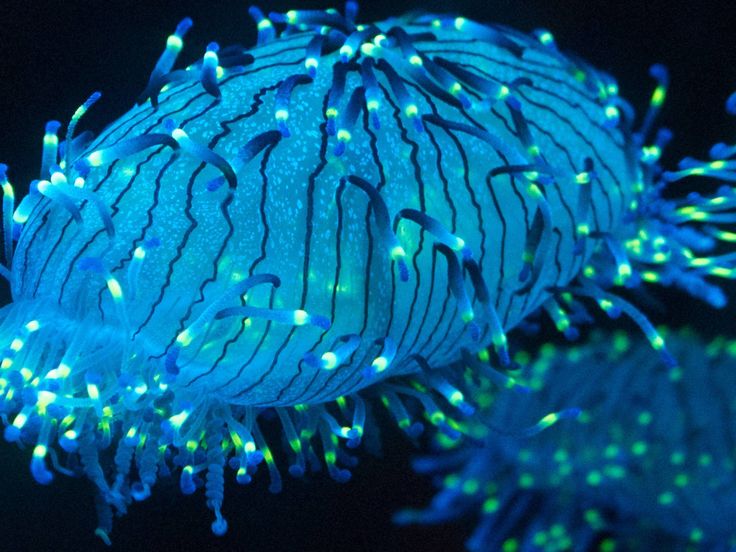 Also, most marine organisms are sensitive only to blue-green colors. They are physically unable to process yellow, red, or violet colors.
Also, most marine organisms are sensitive only to blue-green colors. They are physically unable to process yellow, red, or violet colors.
Most land organisms also exhibit blue-green bioluminescence. However, many glow in the yellow spectrum, including fireflies and the only known land snail to bioluminesce, Quantula striata, native to the tropics of Southeast Asia.
Few organisms can glow in more than one color. The so-called railroad worm (actually the larva of a beetle) may be the most familiar. The head of the railroad worm glows red, while its body glows green. Different luciferases cause the bioluminescence to be expressed differently.
Some organisms emit light continuously. Some species of fungi present in decaying wood, for instance, emit a fairly consistent glow, called foxfire.
Most organisms, however, use their light organs to flash for periods of less than a second to about 10 seconds. These flashes can occur in specific spots, such as the dots on a squid.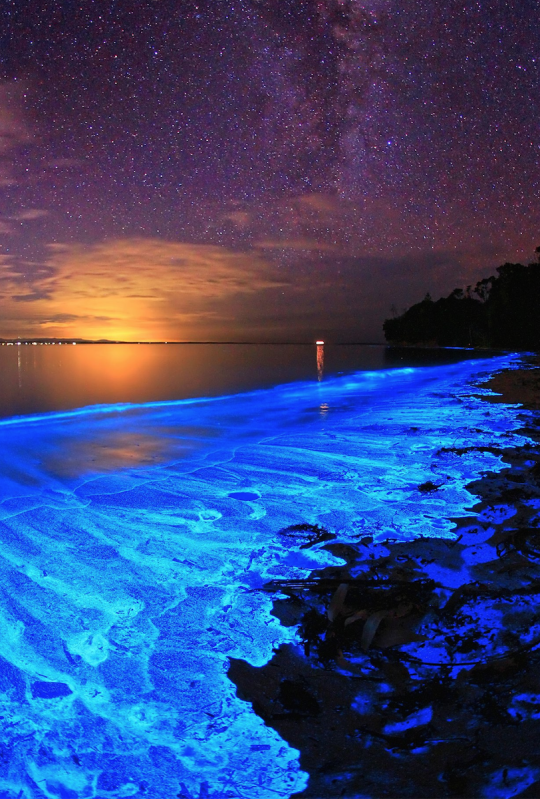 Other flashes can illuminate the organism’s entire body.
Other flashes can illuminate the organism’s entire body.
Adaptations
Bioluminescence is used by living things to hunt prey, defend against predators, find mates, and execute other vital activities.
Defensive Adaptations
Some species luminesce to confuse attackers. Many species of squid, for instance, flash to startle predators, such as fish. With the startled fish caught off guard, the squid tries to quickly escape.
The vampire squid exhibits a variation of this defensive behavior. Like many deep-sea squid, the vampire squid lacks ink sacs. (Squid that live near the ocean surface eject dark ink to leave their predators in the dark.) Instead, the vampire squid ejects sticky bioluminescent mucus, which can startle, confuse, and delay predators, allowing the squid to escape.
Many marine species use a technique called counterillumination to protect themselves. Many predators, such as sharks, hunt from below. They look above, where sunlight creates shadows beneath prey.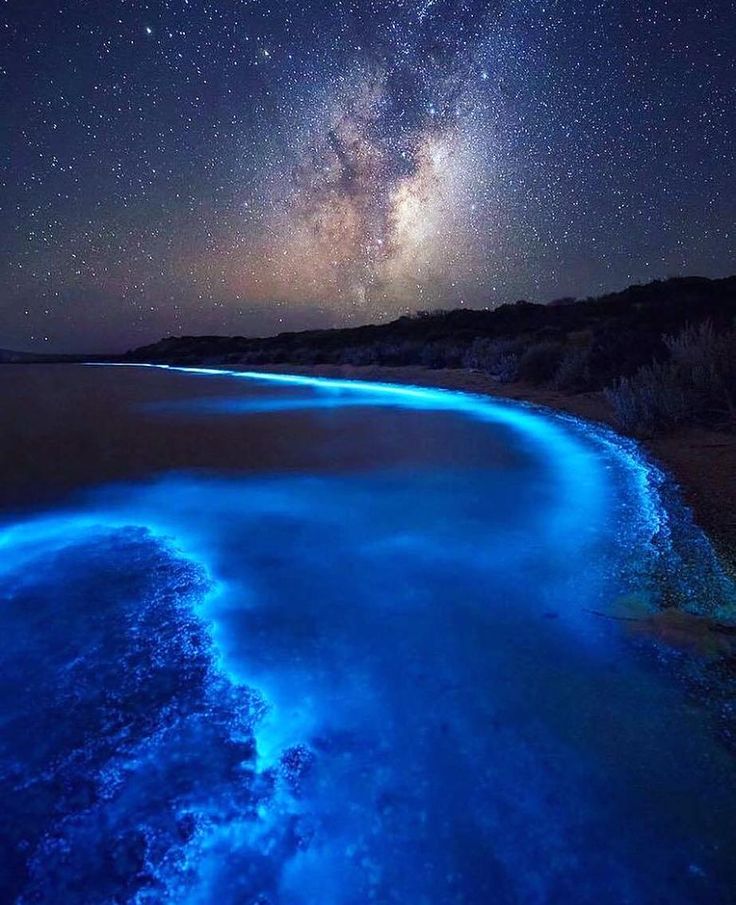 Counterillumination is a type of camouflage against this predatory behavior.
Counterillumination is a type of camouflage against this predatory behavior.
Hatchetfish use counterillumination. Hatchetfish have light-producing organs that point downward. They adjust the amount of light coming from their undersides to match the light coming from above. By adjusting their bioluminescence, they disguise their shadows and become virtually invisible to predators looking up.
Some bioluminescent animals, such as brittle stars, can detach body parts to distract predators. The predator follows the glowing arm of the brittle star, while the rest of the animal crawls away in the dark. (Brittle stars, like all sea stars, can re-grow their arms.)
When some animals detach body parts, they detach them on other animals. When threatened, some species of sea cucumber can break off the luminescent parts of their bodies onto nearby fish. The predator will follow the glow on the fish, while the sea cucumber crawls away.
Biologists think that some species of sharks and whales may take advantage of defensive bioluminescence, even though they are not bioluminescent themselves.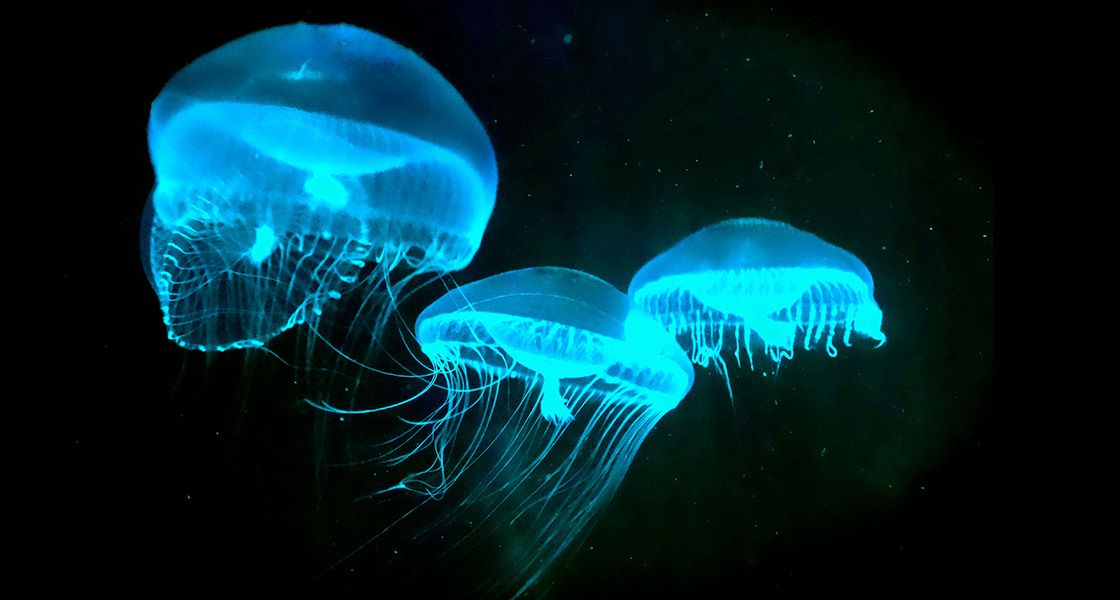 A sperm whale, for instance, may seek out a habitat with large communities of bioluminescent plankton, which are not part of the whale’s diet. As the plankton’s predators (fish) approach the plankton, however, their glowing alerts the whale. The whale eats the fish. The plankton then turn out their lights.
A sperm whale, for instance, may seek out a habitat with large communities of bioluminescent plankton, which are not part of the whale’s diet. As the plankton’s predators (fish) approach the plankton, however, their glowing alerts the whale. The whale eats the fish. The plankton then turn out their lights.
Some insect larvae (nicknamed “glow worms”) light up to warn predators that they are toxic. Toads, birds, and other predators know that consuming these larvae will result in illness and possible death.
Offensive Adaptations
Bioluminescence may be used to lure prey or search for prey.
The most famous predator to use bioluminescence may be the anglerfish, which uses bioluminescence to lure prey. The anglerfish has a huge head, sharp teeth, and a long, thin, fleshy growth (called a filament) on the top of its head. On the end of the filament is a ball (called the esca) that the anglerfish can light up. Smaller fish, curious about the spot of light, swim in for a closer look.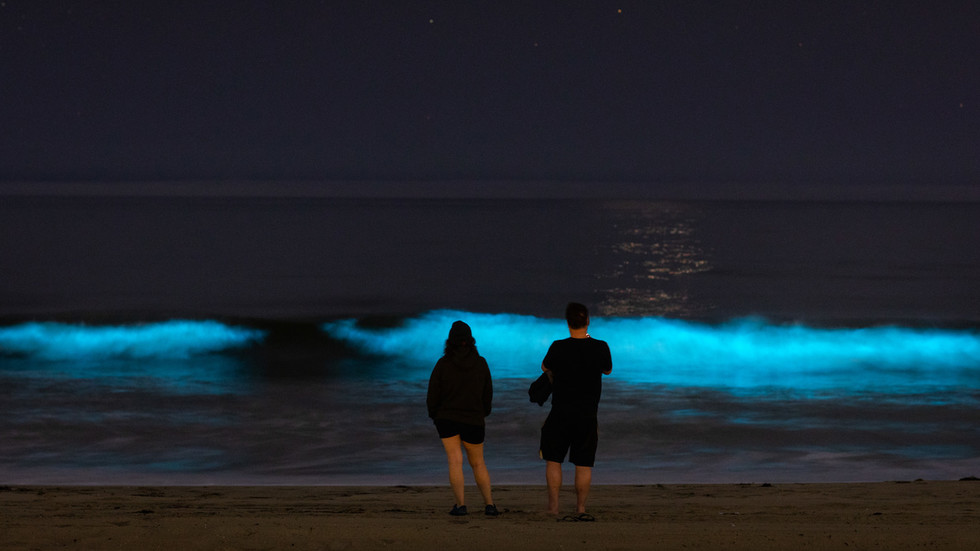 By the time the prey sees the enormous, dark jaws of the anglerfish behind the bright esca, it may be too late.
By the time the prey sees the enormous, dark jaws of the anglerfish behind the bright esca, it may be too late.
Other fish, such as a type of dragonfish called loosejaws, use bioluminescence to search for prey. Loosejaws have adapted to emit red light; most fish can only see blue light, so loosejaws have an enormous advantage when they light up a surrounding area. They can see their prey, but their prey can’t see them.
Attraction
Adult fireflies, also called lightning bugs, are bioluminescent. They light up to attract mates. Although both male and female fireflies can luminesce, in North America most flashing fireflies are male. The pattern of their flashes tells nearby females what species of firefly they are and that they’re interested in mating.
Other Bioluminescence
Organisms can luminesce when they are disturbed. Changes in the environment, such as a drop in salinity, can force bioluminescent algae to glow, for instance. These living lanterns can be seen as spots of pink or green in the dark ocean.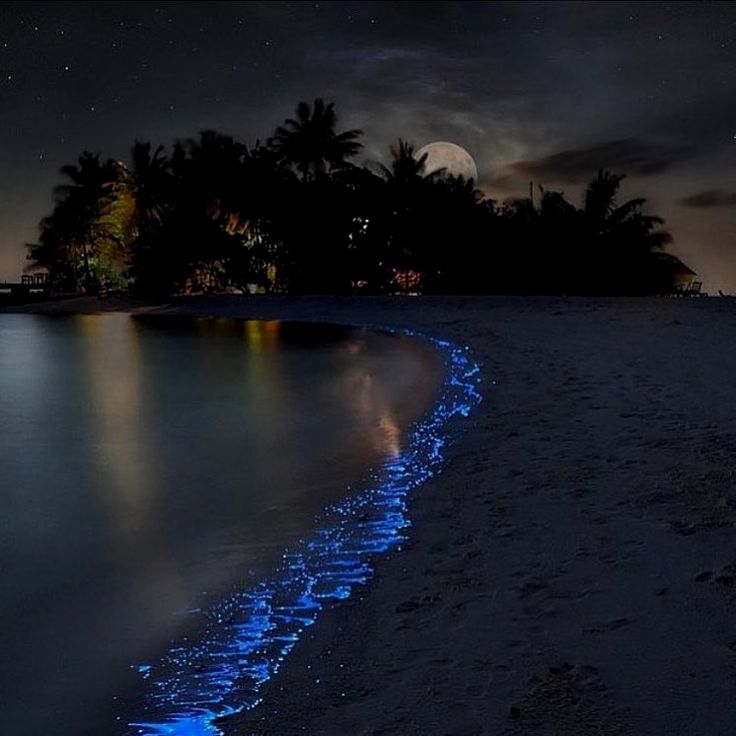
“Milky seas” are another example of bioluminescence. Unlike bioluminescent algae, which flash when their environment is disturbed, milky seas are continuous glows, sometimes bright and large enough to be visible from satellites in orbit above the Earth.
Scientists think milky seas are produced by bioluminescent bacteria on the surface of the ocean. Millions of bacteria must be present for milky seas to form, and conditions must be right for the bacteria to have enough chemicals to light up. Satellite imagery of milky seas have been captured in tropical waters such as the Indian Ocean.
Bioluminescence and People
Biologists and engineers are studying the chemicals and circumstances involved in bioluminescence to understand how people can use the process to make life easier and safer.
Green fluorescent protein (GFP), for instance, is a valuable “reporter gene.” Reporter genes are chemicals (genes) that biologists attach to other genes they are studying.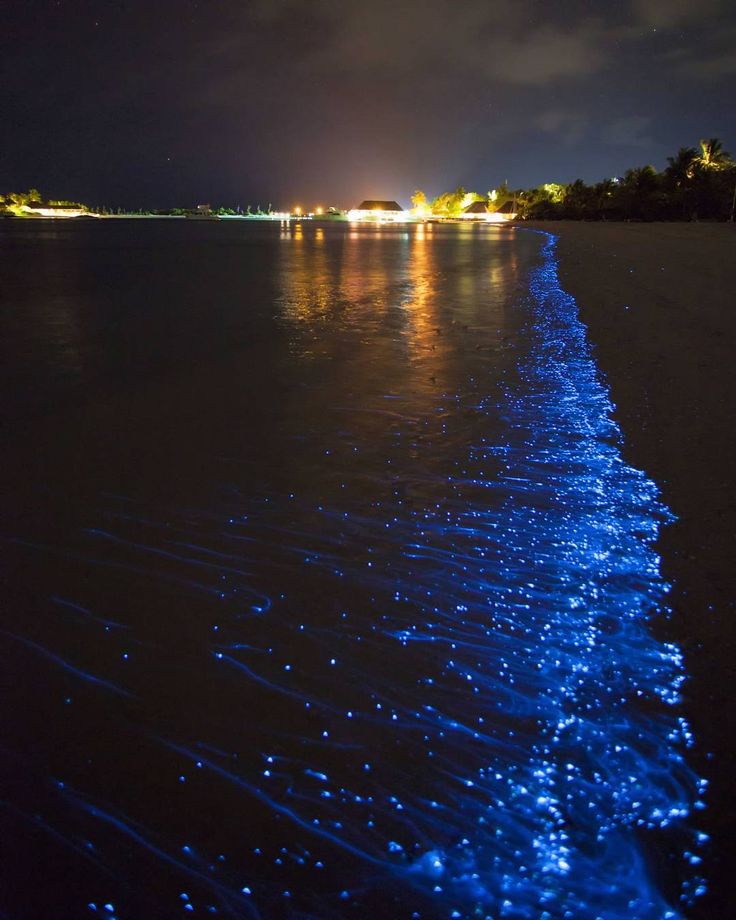 GFP reporter genes are easily identified and measured, usually by their fluorescence. This allows scientists to trace and monitor the activity of the studied gene—its expression in a cell, or its interaction with other chemicals.
GFP reporter genes are easily identified and measured, usually by their fluorescence. This allows scientists to trace and monitor the activity of the studied gene—its expression in a cell, or its interaction with other chemicals.
Other uses are more experimental. Bioluminescent trees, for instance, could help light city streets and highways. This would reduce the need for electricity. Bioluminescent crops and other plants could luminesce when they needed water or other nutrients, or when they were ready to be harvested. This would reduce costs for farmers and agribusiness.
Fast Fact
Bioluminescent DefenseBioluminescence is of great interest to the Navy. When objects move through the ocean, they can cause bioluminescent organisms to flash. This can put projects and people at risk by revealing the presence of submarines, or even Navy SEALs swimming around covertly.
Fast Fact
Dark FreshwaterMost scientists point to two reasons why so few freshwater organisms exhibit bioluminescence.
Video
TED: Edith Widder—The weird, wonderful world of bioluminescence
Reference
The Bioluminescence Web Page
Bioluminescence | Smithsonian Ocean
The Ocean Portal Team
Contents
You may have seen the sparkle of fireflies on a summer’s night. The fireflies produce light through a chemical reaction in their glowing abdomens, a process known as bioluminescence. But did you know that seascapes can also glow and glitter thanks to the light producing abilities of many marine organisms? Some fish dangle a lighted lure in front of their mouths to attract prey, while some squid shoot out bioluminescent liquid, instead of ink, to confuse their predators. Worms and tiny crustaceans also use bioluminescence to attract mates.
Humans primarily see bioluminescence triggered by a physical disturbance, such as waves or a moving boat hull, that gets the animal to show their light off, but often animals light up in response to an attack or in order to attract a mate. Bioluminescent organisms live throughout the water column, from the surface to the seafloor, from near the coast to the open ocean. In the deep sea, bioluminescence is extremely common, and because the deep sea is so vast, bioluminescence may be the most common form of communication on the planet!
Bioluminescent organisms live throughout the water column, from the surface to the seafloor, from near the coast to the open ocean. In the deep sea, bioluminescence is extremely common, and because the deep sea is so vast, bioluminescence may be the most common form of communication on the planet!
Underwater Light
How it’s made
This lanternfish (Diaphus sp.), found in the Red Sea, has light-producing photophores along its ventral surface (belly), and a nasal light organ that acts like a headlight.
(E. Widder, ORCA, www.teamorca.org)
Bioluminescence occurs through a chemical reaction that produces light energy within an organism’s body. For a reaction to occur, a species must contain luciferin, a molecule that, when it reacts with oxygen, produces light. There are different types of luciferin, which vary depending on the animal hosting the reaction. Many organisms also produce the catalyst luciferase, which helps to speed up the reaction.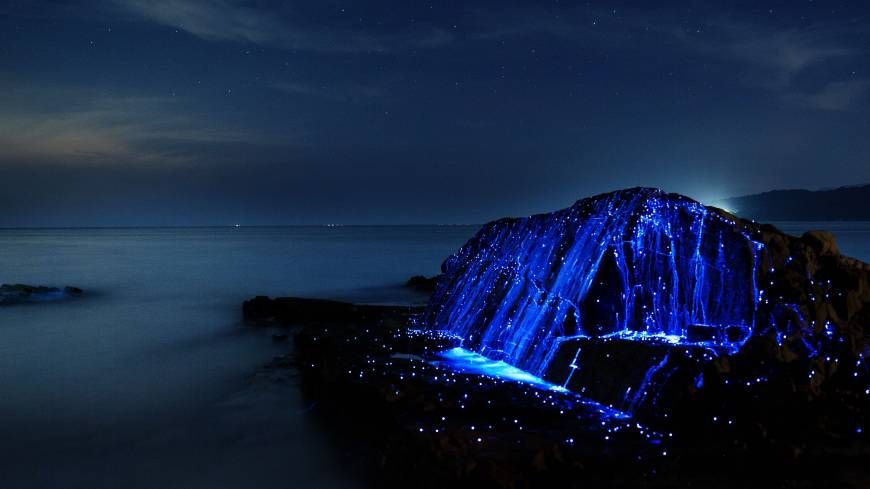
Animals can closely control when they light up by regulating their chemistry and brain processes depending on their immediate needs, whether a meal or a mate. Some organisms even bundle the luciferin with oxygen in what is called a “photoprotein”—like a pre-packaged bioluminescence bomb—that is ready to light up the moment a certain ion (typically calcium) becomes present. They can even choose the intensity and color of the lights.
Who makes it?
Sunset? Time to glow! A biological clock triggers bioluminescence in the dinoflagellate Pyrocystis fusiformis. At dusk, cells produce the chemicals responsible for its light.
(E. Widder, ORCA, www.teamorca.org)
Bioluminescence is found in many marine organisms: bacteria, algae, jellyfish, worms, crustaceans, sea stars, fish, and sharks to name just a few. In fish alone, there are about 1,500 known species that luminesce. In some cases, animals take in bacteria or other bioluminescent creatures to gain the ability to light up. For example, the Hawaiian bobtail squid has a special light organ that is colonized by bioluminescent bacteria within hours of its birth. But usually, the animal itself contains the chemicals necessary for the reaction that produces bioluminescence. The number of species that bioluminesce and the variations in the chemical reactions that produce light are evidence that bioluminescence has evolved many times over—at least 40 separate times! This number continues to grow as research makes new discoveries. In 2018, scientists discovered the ray-finned fishes themselves evolved bioluminescence 27 separate times. That’s quite an increase from the handful of times that were known before.
For example, the Hawaiian bobtail squid has a special light organ that is colonized by bioluminescent bacteria within hours of its birth. But usually, the animal itself contains the chemicals necessary for the reaction that produces bioluminescence. The number of species that bioluminesce and the variations in the chemical reactions that produce light are evidence that bioluminescence has evolved many times over—at least 40 separate times! This number continues to grow as research makes new discoveries. In 2018, scientists discovered the ray-finned fishes themselves evolved bioluminescence 27 separate times. That’s quite an increase from the handful of times that were known before.
Most deep-sea animals produce some bioluminescent light, but the phenomenon isn’t relegated to the deep: one of the most common sightings occurs at the surface of the ocean. Many small planktonic surface dwellers—such as single-celled dinoflagellates—are bioluminescent. When conditions are right, dinoflagellates bloom in dense layers at the surface of the water, causing the ocean to take on a reddish-brown color in daylight and a sparkly sheen as they move in the waves at night.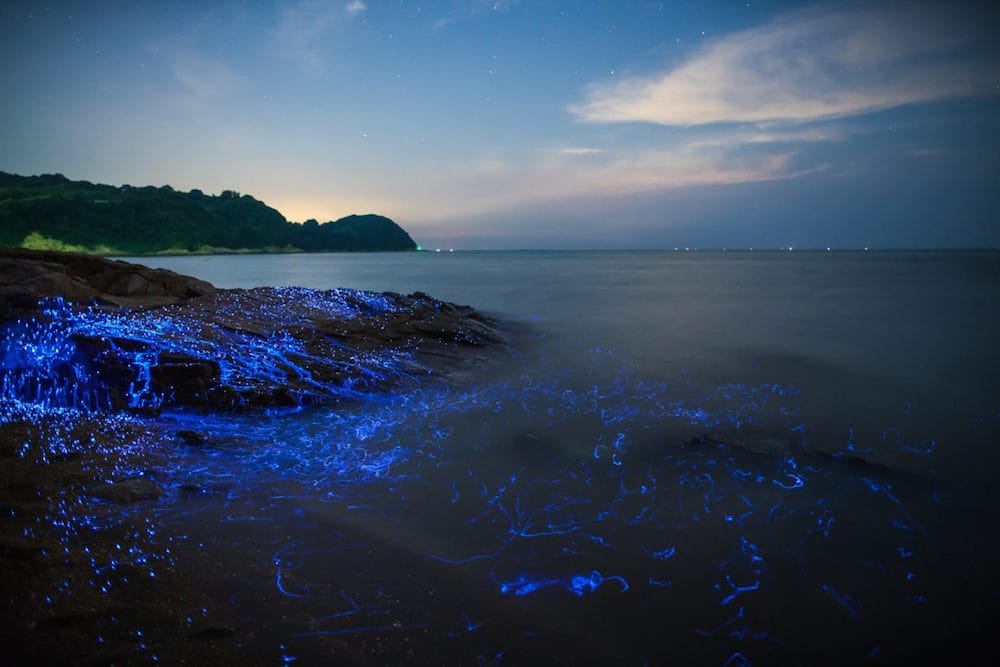 When the dinoflagellates are poisonous to other animals, these events are called harmful algal blooms (HABs). When they’re eaten, the toxic dinoflagellates accumulate in high concentrations in larger fish and filter feeding shellfish. And then when marine mammals or people eat these organisms, it can cause sickness or even death.
When the dinoflagellates are poisonous to other animals, these events are called harmful algal blooms (HABs). When they’re eaten, the toxic dinoflagellates accumulate in high concentrations in larger fish and filter feeding shellfish. And then when marine mammals or people eat these organisms, it can cause sickness or even death.
What Color is Bioluminescence?
The mauve stinger is a glowing jellyfish.
(Fco. Javier Gallardo Álvarez, Flickr)
Light travels in waves of different shapes—known as wavelengths—which determine the color of the light. When the waves hit our eyes, they are translated into colors by the brain depending on their wavelength. The wavelengths that our eyes can see are known as the “visible light spectrum,” and we can see all the colors on this spectrum as they travel through the air above land. But light travels differently underwater because longer wavelengths can’t travel as far. Most of the bioluminescence produced in the ocean is in the form of blue-green light.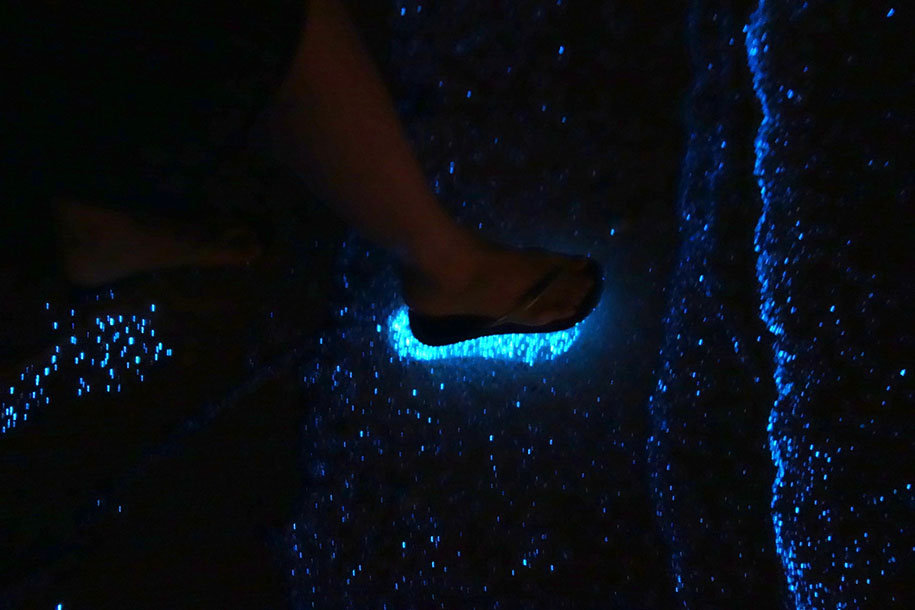 This is because these colors are shorter wavelengths of light, which can travel through (and thus be seen) in both shallow and deep water. Light traveling from the sun of longer wavelengths—such as red light—doesn’t reach the deep sea. This is why many deep sea animals are red: it’s effectively the same as being invisible. Moreover, because it’s not present, many deep-water animals have lost the ability to see it altogether. However, some animals evolved to emit and see red light, including the dragonfish (Malacosteus). By creating their own red light in the deep sea, they are able to see red-colored prey, as well as communicate and even show prey to other dragonfish, while other unsuspecting animals cannot see their red lights as a warning to flee.
This is because these colors are shorter wavelengths of light, which can travel through (and thus be seen) in both shallow and deep water. Light traveling from the sun of longer wavelengths—such as red light—doesn’t reach the deep sea. This is why many deep sea animals are red: it’s effectively the same as being invisible. Moreover, because it’s not present, many deep-water animals have lost the ability to see it altogether. However, some animals evolved to emit and see red light, including the dragonfish (Malacosteus). By creating their own red light in the deep sea, they are able to see red-colored prey, as well as communicate and even show prey to other dragonfish, while other unsuspecting animals cannot see their red lights as a warning to flee.
Why Animals Light Up
Feeding
The yellow bioluminescent ring on this female octopus may attract mates.
(Michael Vecchione/NOAA)
Animals can use their light to lure prey towards their mouths, or even to light up the area nearby so that they can see their next meal a bit better.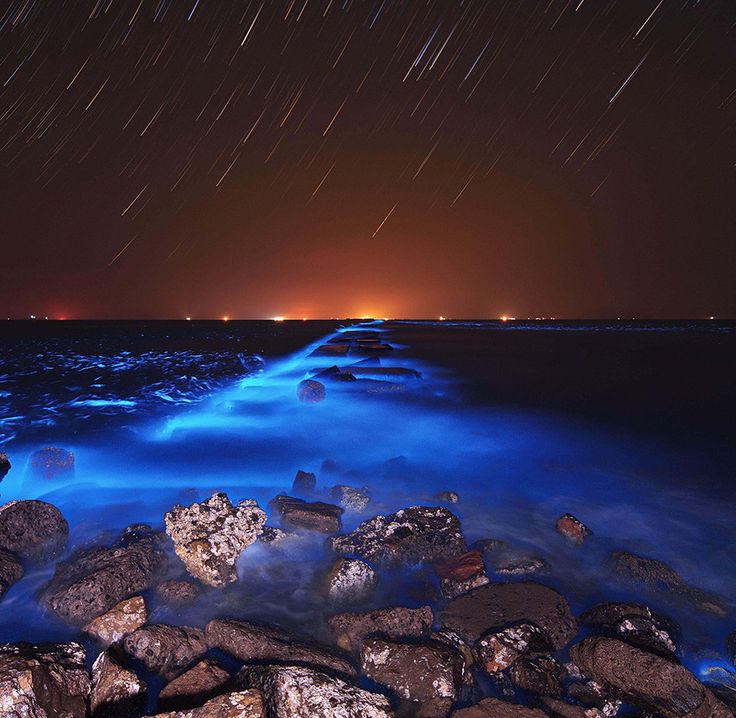 Sometimes the prey being lured can be small plankton, like those attracted to the bioluminescence around the beak of the Stauroteuthis octopus. But the light can also fool larger animals. Whales and squid are attracted to the glowing underside of the cookie-cutter shark, which grabs a bite out of the animals once they are close. The deep-sea anglerfish lures prey straight to its mouth with a dangling bioluminescent barbel, lit by glowing bacteria.
Sometimes the prey being lured can be small plankton, like those attracted to the bioluminescence around the beak of the Stauroteuthis octopus. But the light can also fool larger animals. Whales and squid are attracted to the glowing underside of the cookie-cutter shark, which grabs a bite out of the animals once they are close. The deep-sea anglerfish lures prey straight to its mouth with a dangling bioluminescent barbel, lit by glowing bacteria.
Attracting Mates
Syllid fireworms can be found mainly on the seafloor, but they switch to a planktonic form to reproduce, where the females use bioluminescent signals.
(© 2010 Moorea Biocode)
Animals don’t only need to look for and attract food; bioluminescence can also play a part in attracting a mate. The male Caribbean ostracod, a tiny crustacean, uses bioluminescent signals on its upper lips to attract females. Syllid fireworms live on the seafloor, but with the onset of the full moon they move to the open water where the females of some species, like Odontosyllis enopla, use bioluminescence to attract males while moving around in circles.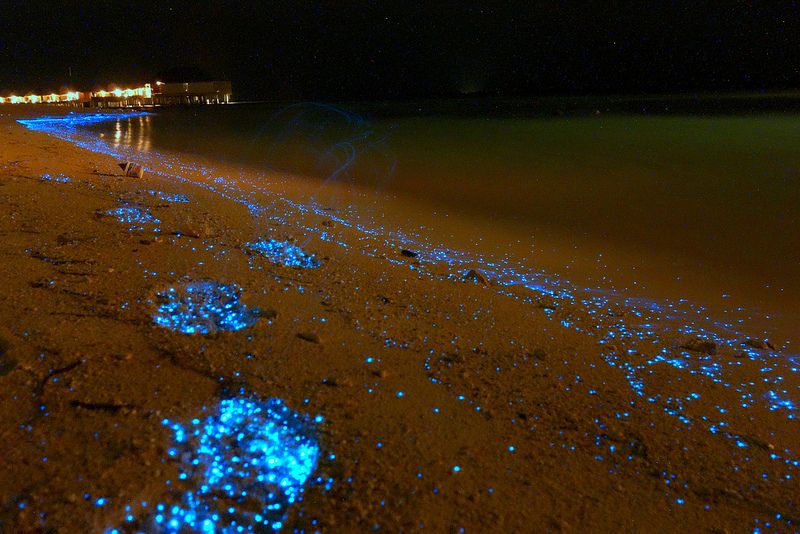 These glowing worms may have even helped to welcome Christopher Columbus to the New World. Anglerfish, flashlight fish and ponyfish all are thought to luminesce in order to tell the difference between males and females, or otherwise communicate in order to mate.
These glowing worms may have even helped to welcome Christopher Columbus to the New World. Anglerfish, flashlight fish and ponyfish all are thought to luminesce in order to tell the difference between males and females, or otherwise communicate in order to mate.
Protection
This fish is using counterillumination to disappear. At left it stands out against the light above it. At right, with bioluminescent structures lit, it blends in.
(Smithsonian Institution)
Often animals use a strong flash of bioluminescence to scare off an impending predator. The bright signal can startle and distract the predator and cause confusion about the whereabouts of its target. From small copepods to the larger vampire squid, this tactic can be very useful in the deep-sea. The “green bomber” worm (Swima bombiviridis) and four other similar worm species from the polychaete family release a bioluminescent “bomb” from their body when in harms way. These deep sea worms live close to the sea bottom and were only discovered in 2009.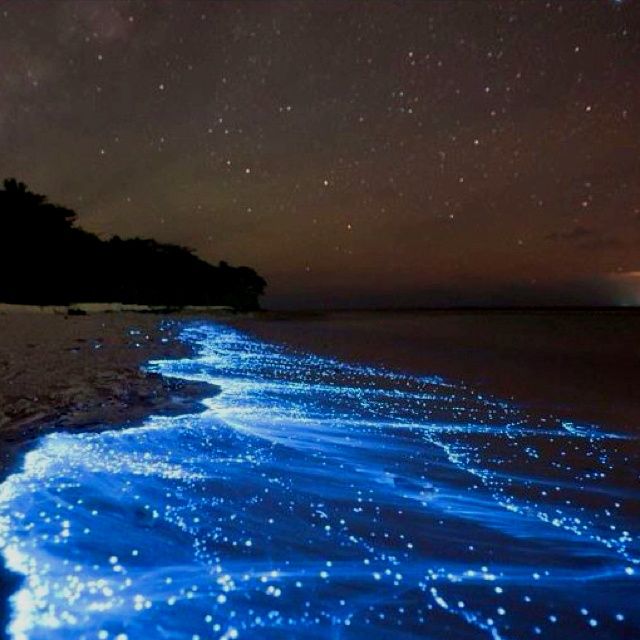 Some animals such as the deep-sea squid Octopoteuthis deletron even detach their bioluminescent arms, which stick to and probably distract their predators. All this commotion could also serve as a burglar alarm, attracting larger predators to the scene. In certain cases a predator might only get a bite of their prey, and the evidence will keep glowing from within its stomach.
Some animals such as the deep-sea squid Octopoteuthis deletron even detach their bioluminescent arms, which stick to and probably distract their predators. All this commotion could also serve as a burglar alarm, attracting larger predators to the scene. In certain cases a predator might only get a bite of their prey, and the evidence will keep glowing from within its stomach.
Bioluminescence can also be used to help camouflage with the use of counterillumination. Photophores on the bottom side of an animal can match the dim light coming from the surface, making it harder for predators searching for prey from below to see what they are looking for.
Human Connections
Art
Using a photographic technique called light painting, this image captures light emitted from a ceramic fish’s mouth.
(Flickr User nickel.media)
For the animals who bioluminesce, it is a matter of communicating and protecting themselves from being eaten or hurt.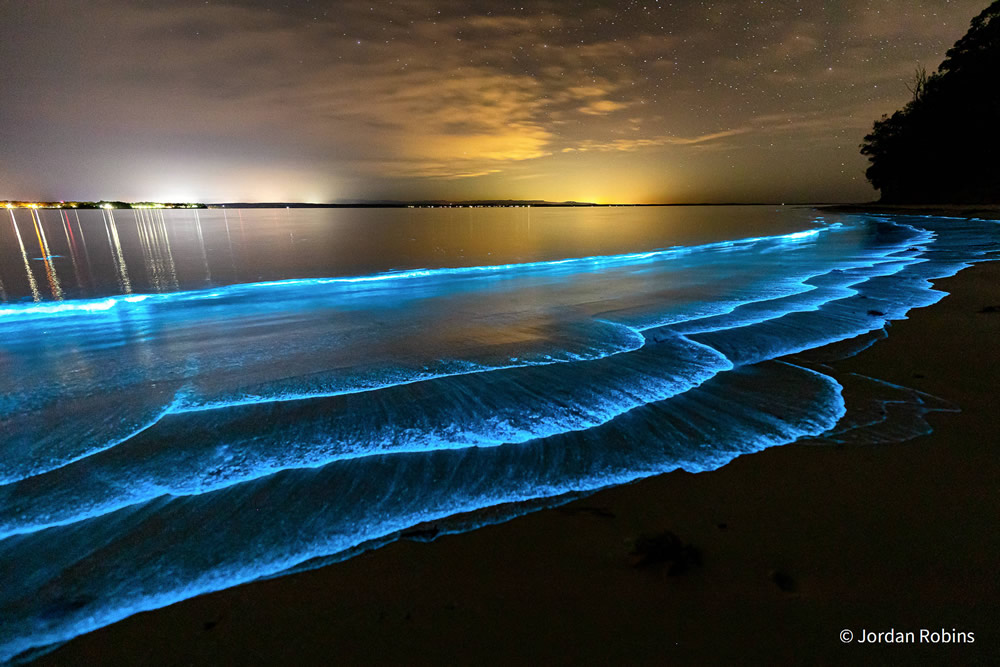 But for humans, the beautiful colors and light that are produced by bioluminescence can be works of art.
But for humans, the beautiful colors and light that are produced by bioluminescence can be works of art.
A temporary exhibit at the National Museum of Natural History in 2012 explored these links between art and science. Artist Shih Chieh Huang created hanging installations in the dark space of the museum that lit up and looked as if they were floating in the deep-sea. Some artists use the bacteria itself to create living drawings or entire exhibits with petri dishes full of the glowing single-celled organisms.
You can also make your own bioluminescent art!
Science
This still of a giant squid is from the first video filmed of the species in its natural habitat.
(NHK/NEP/Discovery Channel )
Bioluminescence can also be used as a tool by researchers to learn more about the ocean and its mysteries. Edie Widder, a scientist who specializes in bioluminescence, was with a group attempting to film the giant squid for the first time. She suspected that the giant squid would be lured to a bioluminescent light attached to a fake squid—not because it wanted to eat the small fake squid, but because its flashing light “burglar alarm” could mean that there was larger prey in the vicinity. Her theory proved right. A live giant squid was captured for the first time on film in 2012!
Her theory proved right. A live giant squid was captured for the first time on film in 2012!
Topics:
Fish
Invertebrates
Plankton
Deep Sea
Tags:
Bioluminescence
Adaptations
Camouflage
Fluorescence
Defenses
what it is, causes, and toxicity
Blue Tears bioluminescent algae in Taiwan.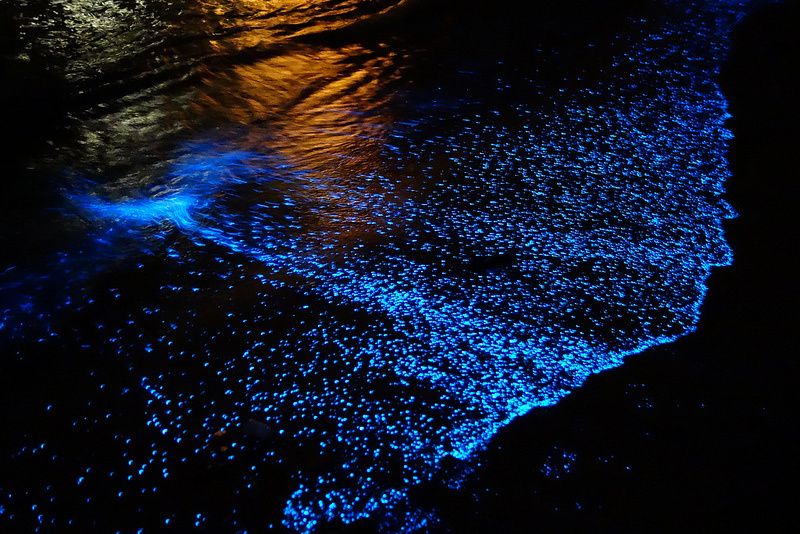 WanRu Chen / Getty Images
WanRu Chen / Getty Images
Bioluminescent algae are a group of tiny marine organisms that can glow in the dark. While this phenomenon can occur in any region or at any depth of the sea, some of the most stunning occurrences occur on the surface, when algae come close to shore, glowing as waves move or when boats collide.
Algae glow is actually a natural defense mechanism; glow occurs when the habitat of algae is disturbed. Single-celled algae called dinoflagellates are almost always responsible for this surface glow. This species is known for producing some of the most common bioluminescent algal blooms. These algae blooms – although extremely beautiful – are associated with harmful environmental impacts and can be dangerously toxic.
What is bioluminescence?
Bioluminescence refers to the light produced by a chemical reaction from a living organism. It occurs in several marine animals, from bacteria and jellyfish to crustaceans and starfish. According to National Oceanic and Atmospheric Administration (NOAA) , 80% of animals that live between 200 and 1000 meters below the ocean surface are bioluminescent (1).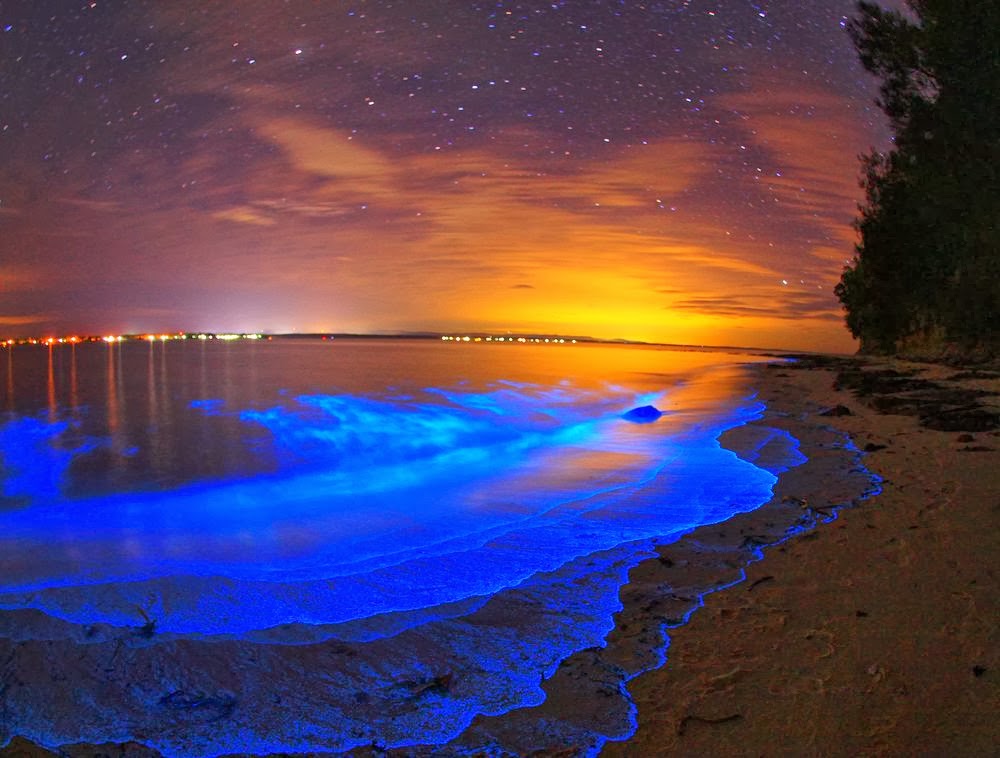
Scientists previously believed that bioluminescence evolved several times in ray-finned fish, but a new study of marine life has shown that this ability arose independently 27 times, dating back at least 150 million years ago (2).
Plankton glow in the Maldives. PawelG Photo / Getty Images
The chemical reaction responsible for this light energy is associated with luciferins, substances that emit light from the body when they react with oxygen. While there are different types of luciferins depending on the animal, some species also produce a catalyst called luciferase that helps speed up the chemical reaction.
Bioluminescence is usually blue, but can also range from yellow to purple to red. In the deep sea, bioluminescence is used as a survival advantage, helping organisms find food, aid reproduction, or, in the case of bioluminescent algae, provide a defense mechanism. Bioluminescence is by no means exclusive to the ocean; fireflies are probably the best known organisms that use bioluminescence to both warn off predators and attract mates.
What causes bioluminescence?
The bioluminescent color resulting from a chemical reaction is the result of a special arrangement of luciferin molecules. Dinoflagellates emit blue light through the luciferin-luciferase reaction, which is actually related to the chemical chlorophyll found in plants. A chemical reaction occurs between the luciferase enzyme catalyst and oxygen when the algae collide in a floating state in the water. Oxygen oxidizes the luciferin molecules, while luciferase speeds up the reaction and releases excess energy in the form of light without generating heat. The intensity, frequency, duration and color of the light depend on the species.
Southern California experiences a “red tide” every few years, caused by Lingulodinium polyedrum , a type of dinophyte. The waters around San Diego turn a rusty color during the day, but at night any movement (whether it be the natural movement of waves or a sliding boat) causes the algae to emit their signature bioluminescent glow.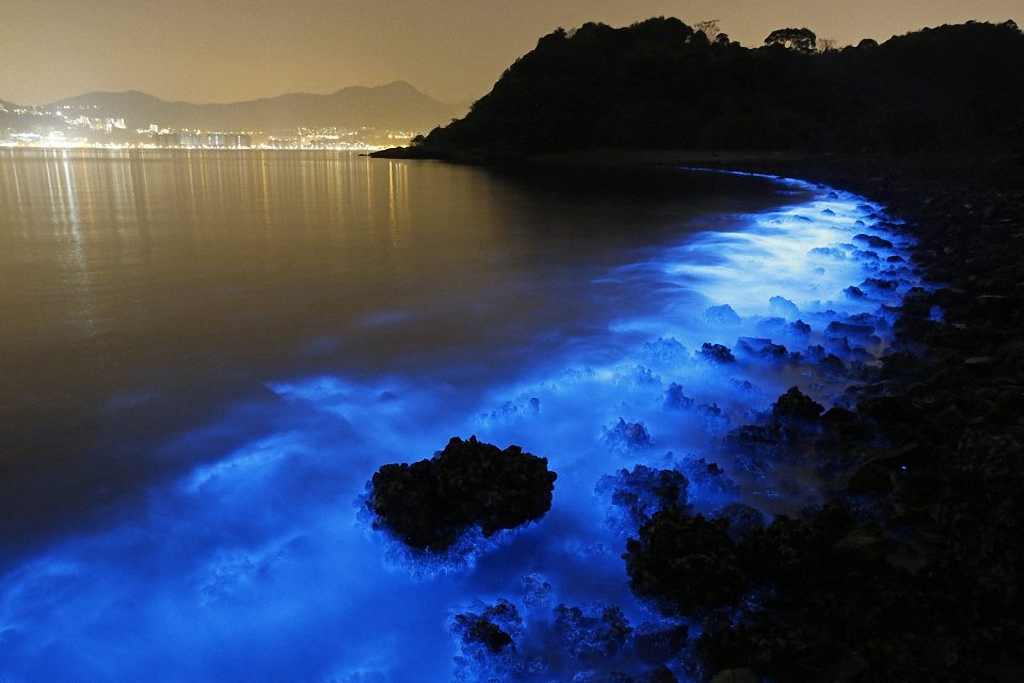
Bioluminescence off the coast of San Diego. Justin Bartels / Getty Images
This rare sight can be found in other parts of the world. Three bioluminescent lagoons in Puerto Rico also have glowing algae, although one such bay at Fajardo’s Laguna Grande has begun to fade in recent years. Some places known for their glows are not caused by algae at all, such as the famous Toyama Bay in Japan; the water here receives its light from phosphorescent creatures called firefly squids that flock to the bay in summer to breed.
Toxicity
When bioluminescent algal species such as dinoflagellates become widespread, harmful algal blooms can occur. Of the 17 classes of dinoflagellate toxins, two are produced by bioluminescent species, and only one of these has been extensively studied. Most scientists agree that both bioluminescence and toxicity act as defenses to deter predators. Interestingly, in some species, both bioluminescent and non-bioluminescent strains exist (3).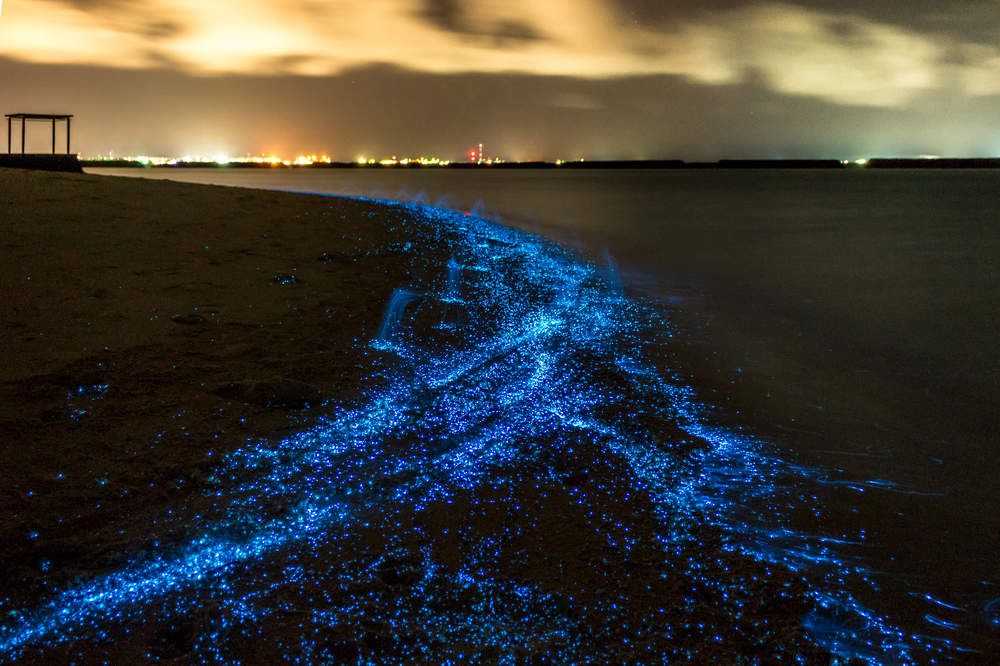
Red tide in New Zealand. Pete Atkinson / Getty Images
Enough microscopic algae can bloom into large, dense patches on the surface of the water. The poisonous algae blooms appear reddish brown (hence the nickname “red tide”) during the day and bright blue at night. When larger fish and filter-feeding clams consume toxic bioluminescent algae in high concentrations, they can transfer the toxicity to marine mammals or humans when eaten. Dangerous levels of toxic algae can cause skin irritation, illness, or even death (4).
During the summer months, for example, the Matsu Islands in Taiwan produce large amounts of bioluminescent algae known as “blue tears”. Studies have shown that the number of toxic algae blooms in the East China Sea is growing every day. In 2019, scientists linked the blue tear phenomenon to poisoned marine life, as algae release ammonia and other chemicals as they feed. Destructive algae were found 300 km from the coast, indicating the spread of blooms.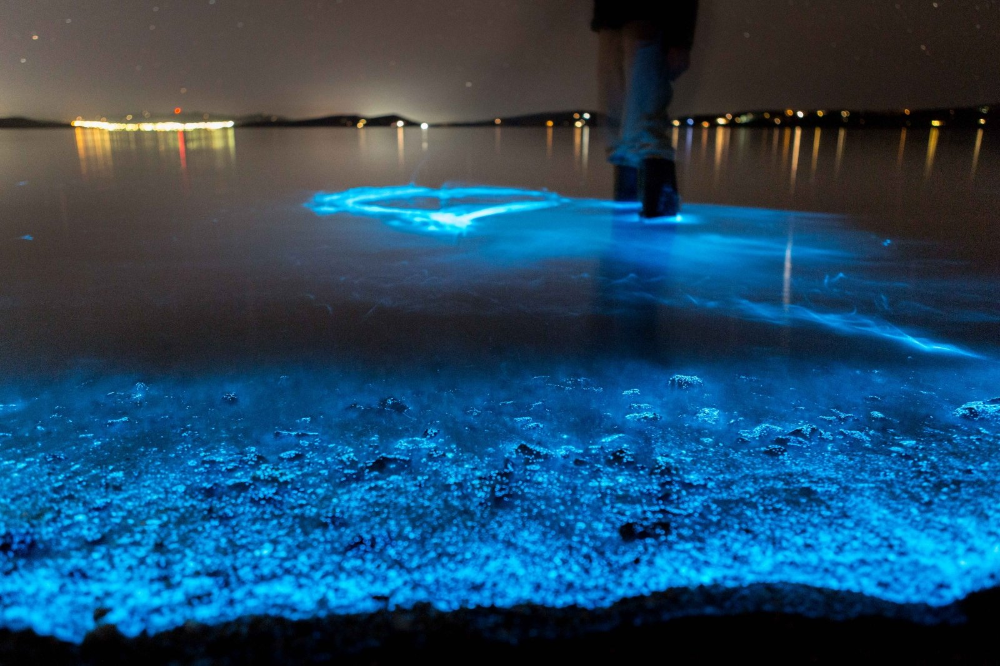 Researchers have suggested that the bloom is caused by the construction of the Three Gorges Dam on the Yangtze River (5).
Researchers have suggested that the bloom is caused by the construction of the Three Gorges Dam on the Yangtze River (5).
Source
Mikhail Sunyaev
Has been working as an environmental and science journalist for over 15 years. He writes about science, culture, space and sustainable development. Freelance author of the site “Knowledge is Light”.
Bioluminescent mushroom – Trowel.zhzh.rf – LiveJournal Primorsky Krai.In the Leningrad Region, it is quite rare). It grows in groups on logs, stumps and trunks of deciduous trees, especially on oaks, beeches and birches.
This is one of the bioluminescent mushroom species.
Small, bitter-tasting fruit bodies of this fungus sometimes completely cover whole stumps. Caps 1-3 cm in diameter, rounded or kidney-shaped, with a folded edge, smooth, moderately sticky, dirty ocher. The plates are frequent, low, with transverse anastomoses, rusty-yellowish. The leg is short, eccentric, widened above, pubescent below, ocher, 0. 5-2 cm long and 2-5 mm thick. Flesh with a bitter taste. Spores are colorless, smooth, cylindrical, curved, amyloid, 2-4 x 1-2 microns.
5-2 cm long and 2-5 mm thick. Flesh with a bitter taste. Spores are colorless, smooth, cylindrical, curved, amyloid, 2-4 x 1-2 microns.
It occurs, as a rule, often during the entire growing season (May – October) in large groups on fallen trunks, but more often on the stumps of some deciduous trees, mainly on alder, birch, oak, etc. Inedible.
Astringent panellus is somewhat similar to the inedible soft panellus ( Panellus mitis ), which is characterized by white or whitish fruit bodies, mild flavor, and grows on dead branches of coniferous trees, mainly spruce.
It has long been known that certain living organisms such as fish, insects and even fungi can emit visible light. By the way, the latter are mentioned in the works of the ancient Greek philosopher Aristotle, as well as the writer Pliny the Elder. However, nowadays researchers still have many questions about the nature of luminous mushrooms.
Like other light-emitting organisms, bioluminescence in fungi is possible through a chemical reaction involving oxygen and luciferin, a light-emitting biological pigment. As a result of this, the tissues of the fungus in which the reaction takes place glow with a greenish light.
Most types of mushrooms emit a faint light that can only be seen in very dark conditions, but there are some that glow quite brightly. For example, the mushroom Poromycena manipularis often has such an intense glow that it can be seen from a distance of 40 meters from it. Under the light, P. manipularis can even be read.
Today, about 70 species of fungi are known to be capable of bioluminescence, but it is still not clear why fungi emit light. According to one of the researchers’ hypotheses, the glow is necessary for some fungi to attract nocturnal animals that spread their spores, thereby helping to reproduce. And according to another version, the emitted light of the fungus serves as a warning about its toxicity to animals.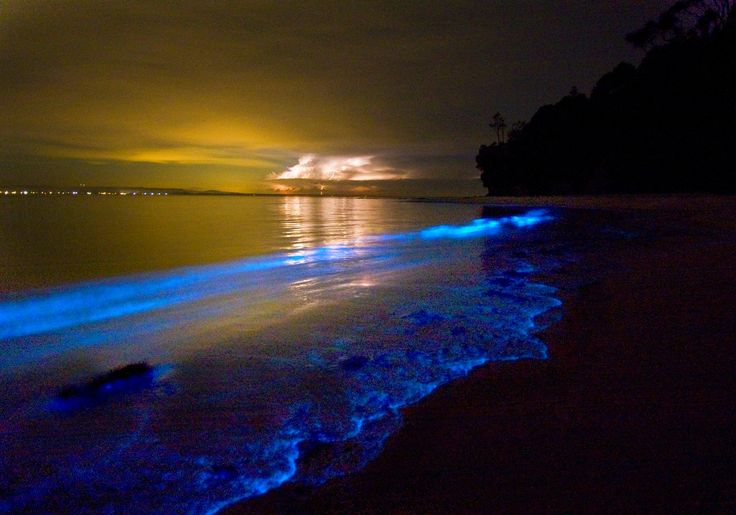
These mushrooms grow into their warm European countries, some even confuse with chanterelles. In fact, this is a mushroom Omphalotus olearius, which feature is a bioluminescent glow, which is especially beautiful at night:
Of course, such photos are taken with a long exposure and you just can’t see it in the forest :-)0005
9000 9000 9000 9000
9000 9000
[ sources ]
sources
http://nat-geo.ru/article/1397-svetyaschiesya-gribyi/
http://atlasgribov.